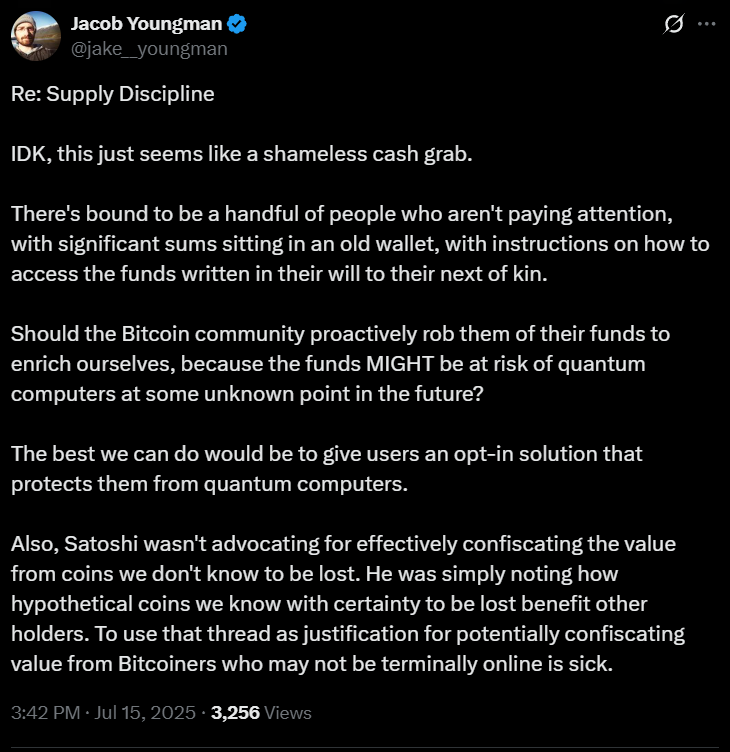-
Bitcoin developers have proposed a groundbreaking plan to phase out legacy cryptographic methods vulnerable to quantum computing attacks, aiming to safeguard the network’s future.
-
This initiative could potentially freeze $593 billion in Bitcoin held in wallets that do not upgrade to quantum-resistant addresses by 2030, including those linked to Satoshi Nakamoto.
-
According to COINOTAG sources, the migration involves a multi-phase strategy that enforces mandatory adoption of post-quantum cryptography to prevent irreversible losses.
Bitcoin developers propose sunsetting vulnerable cryptography to counter quantum threats, risking $593B in frozen wallets if upgrades aren’t completed by 2030.
Bitcoin Developers Outline Quantum-Resistant Migration to Protect $593 Billion in Legacy Wallets
On July 14, a team of prominent Bitcoin contributors, including Jameson Lopp, introduced the “Post Quantum Migration and Legacy Signature Sunset” proposal. This comprehensive plan aims to transition Bitcoin’s cryptographic infrastructure away from vulnerable schemes such as ECDSA and Schnorr, which quantum computers could potentially break within the next decade. The proposal emphasizes a phased approach to mitigate risks, starting with prohibiting new transactions to legacy addresses and culminating in the invalidation of all legacy cryptographic transactions at a predetermined block height. This approach is designed to encourage timely migration to quantum-resistant Pay-to-Quantum-Resistant-Hash (P2QRH) addresses, thereby securing the network against emerging quantum threats.
Phased Migration Strategy to Secure Bitcoin Against Quantum Computing Risks
The migration plan is structured into three distinct phases. Phase A initiates the process by disallowing new transactions to legacy addresses, nudging users toward quantum-secure alternatives. Phase B enforces a hard cutoff, rendering all legacy cryptographic transactions invalid after a specific block height, effectively freezing funds in non-upgraded wallets. Phase C, still under development, proposes a recovery mechanism leveraging zero-knowledge proofs to authenticate wallet ownership for users who miss the migration deadline. This phased approach balances security imperatives with user flexibility, aiming to minimize disruption while ensuring the network’s long-term resilience.
Quantum Computing: An Imminent Threat to Bitcoin’s Security Model
The proposal highlights that approximately 4.9 million BTC, valued at nearly $593 billion, remain exposed due to legacy address formats such as Pay-to-Public-Key (P2PK) and reused public keys. Notably, the wallets attributed to Bitcoin’s creator, Satoshi Nakamoto, holding around 1 million BTC, fall within this vulnerable category. The developers stress that failure to upgrade these wallets could lead to irreversible losses if quantum adversaries exploit exposed public keys to steal funds covertly. This risk underscores the urgency of the migration, as the advent of practical quantum computing could undermine trust in Bitcoin’s foundational security assumptions.

Community Response and the Path Forward
The proposal has sparked debate within the Bitcoin community, with some members expressing concerns over the potential freezing of funds and the unprecedented nature of enforcing a mandatory cryptographic upgrade. However, developers argue that delaying action increases the risk of catastrophic losses once quantum attacks become feasible. They reference recent advancements in quantum-resistant algorithms, including the National Institute of Standards and Technology’s (NIST) 2024 ratification of post-quantum signature schemes, as evidence that the threat window is narrowing. While hardware capable of executing quantum attacks at scale remains in development, the accelerating pace of algorithmic progress necessitates proactive measures.
Implications for Bitcoin’s Security and User Adoption
Historically, Bitcoin has been cautious in adopting protocol changes, often requiring extensive community consensus. This proposal seeks to expedite the migration by establishing a clear timeline and flag day, encouraging coordinated action among stakeholders. If implemented, it would mark the first instance in Bitcoin’s history where unspent coins could be permanently disabled due to non-compliance with updated security standards. This shift underscores the evolving nature of blockchain security in the quantum era and highlights the importance of continuous innovation to maintain trust and network integrity.
Conclusion
The Bitcoin community faces a pivotal moment as it confronts the quantum computing threat. The proposed migration to quantum-resistant cryptography represents a proactive and structured response to an emerging risk that could jeopardize billions in assets. While challenges remain in achieving consensus and ensuring smooth migration, the plan sets a precedent for future-proofing Bitcoin’s security. Users and institutions are urged to monitor developments closely and prepare for mandatory upgrades to safeguard their holdings in the coming decade.






